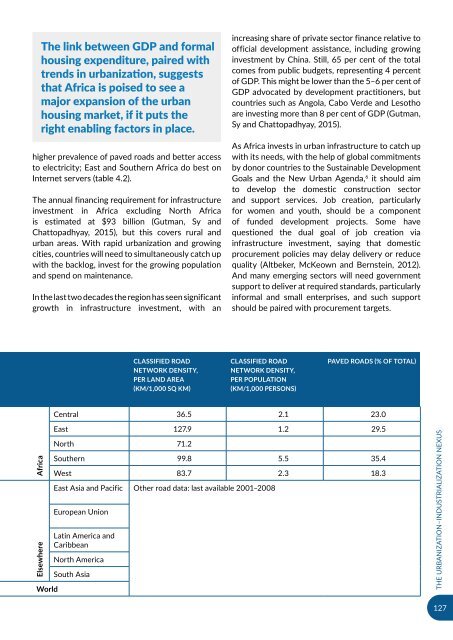URBANIZATION AND INDUSTRIALIZATION
Economic%20Report%20on%20Africa%202017%20UNECA
Economic%20Report%20on%20Africa%202017%20UNECA
You also want an ePaper? Increase the reach of your titles
YUMPU automatically turns print PDFs into web optimized ePapers that Google loves.
The link between GDP and formal<br />
housing expenditure, paired with<br />
trends in urbanization, suggests<br />
that Africa is poised to see a<br />
major expansion of the urban<br />
housing market, if it puts the<br />
right enabling factors in place.<br />
higher prevalence of paved roads and better access<br />
to electricity; East and Southern Africa do best on<br />
Internet servers (table 4.2).<br />
The annual financing requirement for infrastructure<br />
investment in Africa excluding North Africa<br />
is estimated at $93 billion (Gutman, Sy and<br />
Chattopadhyay, 2015), but this covers rural and<br />
urban areas. With rapid urbanization and growing<br />
cities, countries will need to simultaneously catch up<br />
with the backlog, invest for the growing population<br />
and spend on maintenance.<br />
In the last two decades the region has seen significant<br />
growth in infrastructure investment, with an<br />
increasing share of private sector finance relative to<br />
official development assistance, including growing<br />
investment by China. Still, 65 per cent of the total<br />
comes from public budgets, representing 4 percent<br />
of GDP. This might be lower than the 5–6 per cent of<br />
GDP advocated by development practitioners, but<br />
countries such as Angola, Cabo Verde and Lesotho<br />
are investing more than 8 per cent of GDP (Gutman,<br />
Sy and Chattopadhyay, 2015).<br />
As Africa invests in urban infrastructure to catch up<br />
with its needs, with the help of global commitments<br />
by donor countries to the Sustainable Development<br />
Goals and the New Urban Agenda, 6 it should aim<br />
to develop the domestic construction sector<br />
and support services. Job creation, particularly<br />
for women and youth, should be a component<br />
of funded development projects. Some have<br />
questioned the dual goal of job creation via<br />
infrastructure investment, saying that domestic<br />
procurement policies may delay delivery or reduce<br />
quality (Altbeker, McKeown and Bernstein, 2012).<br />
And many emerging sectors will need government<br />
support to deliver at required standards, particularly<br />
informal and small enterprises, and such support<br />
should be paired with procurement targets.<br />
CLASSIFIED ROAD<br />
NETWORK DENSITY,<br />
PER L<strong>AND</strong> AREA<br />
(KM/1,000 SQ KM)<br />
CLASSIFIED ROAD<br />
NETWORK DENSITY,<br />
PER POPULATION<br />
(KM/1,000 PERSONS)<br />
PAVED ROADS (% OF TOTAL)<br />
Central 36.5 2.1 23.0<br />
Africa<br />
Elsewhere<br />
World<br />
East 127.9 1.2 29.5<br />
North 71.2<br />
Southern 99.8 5.5 35.4<br />
West 83.7 2.3 18.3<br />
East Asia and Pacific Other road data: last available 2001–2008<br />
European Union<br />
Latin America and<br />
Caribbean<br />
North America<br />
South Asia<br />
THE <strong>URBANIZATION</strong>–<strong>INDUSTRIALIZATION</strong> NEXUS<br />
127


